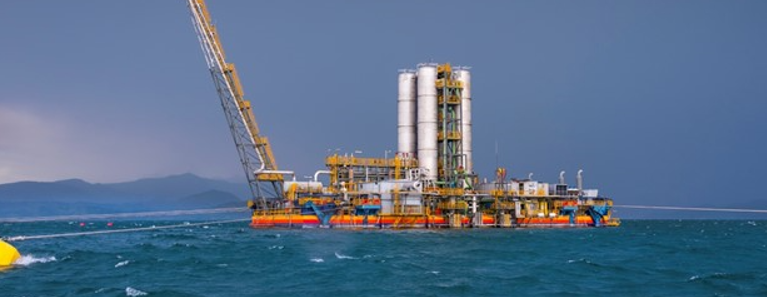


At the bottom of Lake Kivu, between the Democratic Republic of Congo (DRC) and Rwanda, at more than 250 meters deep, 65 cubic kilometers of methane gas lies dormant.
Fermented plant residue and sewage is transformed into the gas. This process is ongoing. The amount of methane continues to grow. This is an ecological disaster waiting to happen. As the water becomes saturated with the gas, the gas will eventually rise to the surface. If nothing is done about the build-up of gas, this is forecasted to happen by the end of the century. Or volcanic activity in the region could disturb the gas and cause it to rise.
Although methane gas is a greenhouse gas that has an impact on the ozone layer, this is not the immediate threat. The methane gas is mixed with large quantities of carbon dioxide, a lethal gas that is heavier than oxygen. Should it come to the surface it would roll out and cover the surroundings of the lake like a blanket. This would kill all life in the wider vicinity of the lake. 9 million people as well as all nearby animals would be at risk. This is exactly what happened in Cameroon around Lake Nyos, in 1986.
The amount of methane continues to grow. This is an ecological disaster waiting to happen
The methane gas at the bottom of Lake Kivu also poses an economic opportunity. Electricity can be generated from the gas. If it were possible to extract the gas from the lake, this could provide the surrounding communities with a continuous flow of energy. This would be a great stimulus for a country like Rwanda, which has shown great economic growth in recent years, but has suffered from a limited and inconsistent power supply. Simultaneously, safe extraction of the gas would reduce the risk of ecological disaster drastically. Moreover, it would enable the Rwandan economy to rely less on energy generated from diesel fuel, which is expensive and polluting.
To accomplish this, the company Kivuwatt was created by Contour Global, a global power generation company. Kivuwatt has been co-financed by FMO and its partners the African Development Bank, the Emerging Africa Infrastructure Fund and BIO, the Belgian DFI through project finance debt that represents 43% of the required investment for the project.
Extracting methane gas from such a depth is easier said than done. Moreover, building a facility on the scale of Kivuwatt had never been done before. The gas extraction facility is located 13 km from the shore and is tethered to the bottom of the lake. The nature of the project required maritime engineering expertise not readily available in Rwanda, 2200 kilometres from the sea. The complexity of the process lies in extracting and reinjecting the water from the lake at exactly the right depths. The lake consists of layers of water with different densities. These different densities keep the gases at the bottom of the lake in place. The water containing methane and carbon dioxide is brought up a depth of 350 metres. After the methane gas has been separated from the water and compressed on a barge facility on the lake surface, it is purified of CO2 and transported to the shore where it is converted into electricity. The water then needs to be inserted back at a depth with similar density. Releasing it too deep means disturbing the gas and disturbing the balance. With the risk of causing the gas to risk to the surface. It would also dilute the methane gas, which makes it harder to extract. Releasing it above 60 metres would disturb the biosphere in the lake, killing fish and other lifeforms, causing the surrounding fishing communities to lose their livelihoods.
The methane gas at the bottom of Lake Kivu also poses an economic opportunity. Electricity can be generated from the gas.
Rwanda and the Democratic Republic of Congo (DRC) have agreed on equal rights to the methane deposit. Additionally, they have agreed management prescriptions that serve as guidelines for extraction of the gas. Currently, it is Rwanda that is most active in and benefits the most from the Kivuwatt project. The government has agreed a 25-year concession with the company and the utility company Rwanda Energy Group (REG) has signed a 25-year power purchase agreement (PPA) with Kivuwatt. To supervise the project the Lake Kivu Monitoring Program (LKMP) was created. This regulatory body is to be trilaterally managed by Rwanda, the DRC and Burundi.
Kivuwatt is part of a broader effort by the Rwandan government and the REG to increase access to energy and to ensure the delivery is reliable, sustainable and affordable. The yearly energy production target for Kivuwatt is 220 GWh. This represents 25% of the country’s total energy production. With Kivuwatt operational, energy has become more accessible. Consequently, the Rwandan deficit has also gone down, because the country can reduce its subsidies for affordable energy and imports of expensive diesel fuel. Moreover, less diesel fuel means less greenhouse gas emissions. Because of Kivuwatt, emissions of the energy sector have been reduced by 44% (from 308 gCO2 to 134 gCO2 per KWh).
With Kivuwatt operational, energy has become more accessible.
The effects of Kivuwatt and a more affordable and stable energy supply can be felt across Rwandan society. For instance, individual households and health centers now rely less on expensive diesel fuel for their own power supply. People can easily charge their mobile phones from home, instead of walking to a village charging point. Children spend longer studying at home after sunset. In newly connected households people are taking up new crafts and other business activities. In villages with new access to electricity, a recent survey shows less dependence on farming jobs and people entering into better paid jobs. There is also increased investment in electrical and electronic equipment. This is up 17% among health centers and the average number of computers per school increased by 65,3%. Clear evidence that electricity literally lights the path towards sustainable economic growth.
As a company Kivuwatt has also made every effort to become part of the local community. It now employs 111 people, 58% of which are Rwandan and 20% are women. It supports its staff with extensive training programmes to help them become more qualified employees.The company is also actively involved in several local projects. It has invested in 15 projects so far, in and around Kibuye. Among them the refurbishment of the only pre-primary school in Kibuye, the donation of cows to a local village, setting up the ‘farming’ of large Isambaza and Tilapia fish, and building 5 water collection points.
To reap the full benefits of the Kivuwatt project has required considerable effort by all those involved.
To reap the full benefits of the Kivuwatt project has required considerable effort by all those involved. FMO has been tirelessly involved from the beginning. Not just with financing and its ESG expertise, but by also by facilitating negotiations and mediating in conflicts between the companies, ministries and other organisations whenever this was needed.
These efforts will not cease now that the site is operational. Doing will continue to make the difference.